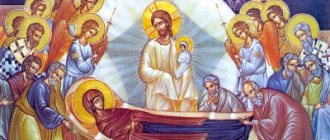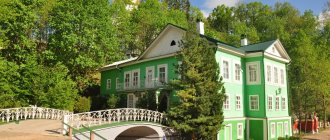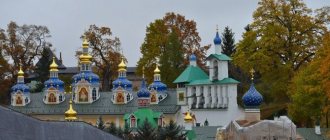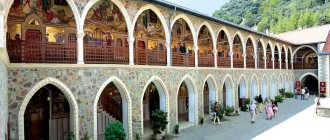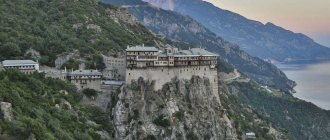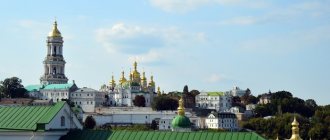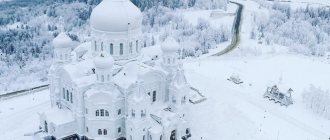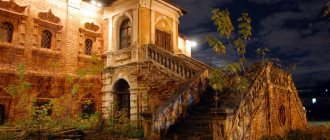History of the Pskov-Pechersky Monastery
1392 was the year of the opening of the “God-created caves.” A witness to this was the peasant landowner Ivan Dementyev. After this event, escaping from the persecution of the Tatars, monks settled there. Unfortunately, the names of all of them have not reached our times. Only St. Mark is known, who founded the Pskov-Pechersky Monastery.
Near the caves, in 1470, John dug a home for himself and settled here with his wife Mary. The Assumption Church was founded on this site, illuminated in 1473. Ivan Dementyev, seeing the efforts of the monks, decided to transfer part of the land for their use. A monastery began to form at this place, and the caves were turned into a burial place for the monastery’s servants.
Only in 1523 were the first fortifications built - wooden walls. In the same year, the cave temple was expanded, and the Church of Anthony and Theodosius was built on the Holy Mountain.
When abbot Cornelius began his duties, it became noticeable how the monastery was growing. He managed to attract 200 new monks here, although there were only 18 of them before him. He also managed to build more powerful fortifications, turning wooden walls into stone ones. The Church of St. Nicholas the Goalkeeper was built during the reconstruction of the walls (1558-1565).
Between 1758 and 1870, several more buildings were built:
- 1758-1759 – Intercession Church;
- 1729-1800 – Church of Lazarus;
- 1815-1827 – St. Michael’s Cathedral;
- 1870 – Sretenskaya Church.
The monastery that never closed
And this is no longer a legend, but a fact. Over 550 years of history, the monastery was destroyed more than once, but neither wars, nor the alienation of lands in favor of different states, nor rulers could close it.
After destruction, the monastery was always restored and received another feat of arms to add to history. And the brethren not only participated in protection and restoration, but always helped parishioners in trouble.
During the Livonian War they carried out missionary activities. They founded churches in the conquered areas, provided assistance to the victims, and the names of those killed in the war were entered into the monastery synodik for commemoration. During the German occupation, the brethren of the monastery participated in the Pskov Orthodox mission , which revived spiritual life in the occupied territories.
State borders moved, but did not disturb the monastic peace. But the Soviet government decided to seriously address the issue of unquenchable faith in the Pskov region.
Various commissions visited the monastery repeatedly, with the sole purpose of closing the monastery. Once again the commission arrived, this time with a closure order. But its abbot Alypius only glanced at the papers and immediately threw them into the burning fireplace. No papers - no reason to close.
Before the next commission, the monastery gates were simply closed. And Alypiy said that the monastery had preserved a lot of weapons from the times of the war and many of the brethren were front-line soldiers who would fight to the last. Alypiy further said that it would be possible to take the monastery only with the help of aviation, which would certainly be reported on by the Voice of America.
They say that after this, even the Soviet government abandoned all attempts to close the Pechersky Monastery.
Current status of the Pskov-Pechersky Monastery
The Pskov-Pechersky Monastery is extremely beautiful. Throughout the history of its development, it was surrounded with care and attention, thanks to this it became a revered shrine for the Russian people. From the outside, the monastery is a fortress with many loopholes.
The entire length of the walls is 800 meters and they have 9 towers. In the courtyard, the architecture accommodates several temples and other monastery buildings.
At the end of the last century, the premises located inside the monastery were subject to restoration. Despite its long history, the traditions inside the monastery have remained the same and have not changed.
Content
- 1. History
- 2 Current state 2.1 God-created caves
- 2.2 Temples
- 2.3 Monastery walls and towers
- 8.1 Schedule of services
Interesting facts and legends
A tragic fact is known about the venerable martyr Cornelius. At that time, Ivan Vasilyevich the Terrible ruled the country, and rumors reached him that the supposed mentor of the Pskov-Pechersk Monastery refused to obey the tsar and was plotting intrigues to rule the state himself.
Grozny could not forgive this and set off on his journey. Near the gates of the monastery, abbot Cornelius was already waiting for him, suspecting nothing. The king was very angry, without remembering himself, he pulled out a sword and cut off his head with his own hand. The head rolled down the hill, sprinkling blood all the way. After this, the path was nicknamed the Bloody Path and a religious procession is held along it every year in memory of this event.
The king, having come to his senses, greatly regretted what he had done and ordered Father Cornelius to be buried on the territory of the monastery. In the Pskov-Pechersk holy land, once a novice Tikhon Shevkunov was undergoing obedience. In 1986, he made a film about the internal life and architectural structures of the monastery. He also owns the book “Unholy Saints.”
The monastery today
In 1968, the monastery had 83 monks on staff, 16 of them with higher education: engineers, teachers, front-line soldiers. And also several dozen novices - candidates for monks. Candidate period is from 2 to 14 years, depending on their diligence. The monastery paid a fee to the state for the land.
Monastic buildings are state property , and the monks were served by 25 hired workers. The abbot of the monastery, Archimandrite Alipius, was 53 years old at that time. A participant in the Great Patriotic War, he graduated from the Grekov Higher Art Academy and the Moscow Theological Academy.
Since 1995, the abbot of the monastery Archimandrite Tikhon . Thanks to his efforts, the monastery is being improved and decorated. A fraternal stone building was built near the Lower Lattice tower with a bathhouse and a laundry room, the fortress walls were covered with copper, and the domes of the temples and ancient paintings on the facades were restored.
On the shore of Lake Pskov, the monastery opened the Priozerny monastery. The traditions of the monastery are carefully preserved. In the 7th week after Easter, the day of the miraculous icon “Tenderness” is celebrated. The day of the Council of Pskov-Pechersk Saints is regularly celebrated. The monastery continues publishing activities.
Shrines of the Pskov-Pechersk Monastery
Valuable icons are kept in the monastery. There are three shrines in total in the monastery - this is the icon of the Mother of God, with which annual religious processions take place; Hodegetria and the Icon of Tenderness.
The chronicles describe cases of miraculous healings when touching miraculous shrines. The Assumption Church and St. Michael's Cathedral are considered places where icons are kept.
Interesting[edit]
- “Pskov-Pechersk Monastery”
- a film with this name was created by Archimandrite Tikhon (Shevkunov), based on materials filmed at the monastery in 1986, where he labored. - “Unholy Saints and Other Stories”
, as well as stories about the Pskov-Pechersk Monastery, was published
God-given caves
During the opening of the caves, events took place that carry a secret meaning. This happened in 1392, the same year Sergius of Radonezh left the world, and at the same time prayer books were opened, which were tied up in these caves.
According to the chronicles, they were hidden from human sight. But one day a peasant witnessed a miracle. It was as if an entrance had opened under the trees, and above it there was an inscription: “Caves created by God.”
The Pskov-Pechersk Monastery is famous for its miraculous caves.
No one knows who wrote it, but it had an interesting property - it could not be erased. There is confirmation of this in the chronicles. As if in the 16th century, the monk Varlaam often visited the caves and constantly erased the inscription, but it appeared again.
In later times, the entrance was lined with bricks to give the monastery a decent appearance, and then the inscription was laid. At that time, everyone already knew that the monastery was under the protection of God and was created by his hand.
Assumption Cave and Intercession Churches
The oldest building in the monastery, and even in Russia, is the Assumption Church. It was founded by the Monk John, who after tonsure received the name Jonah. The monk came here with his wife and dug a cave in the sandy mountain, where the two of them settled.
Maria (wife) was a faithful helper in the formation of the church. In 1473, the shrine was illuminated during the Feast of the Assumption.
At the Assumption Church, only the facade is visible, the opposite side is not visible, because the back part is located in the mountain. Hegumen Dorotheos in 1523 expanded the temple walls and built a chapel for Anthony and Theodosius. 1858 was the year of construction of the Church of the Intercession, which is located above the Church of the Assumption.
Their entrances are located on different sides. To get to the upper church, you must first go down into the caves, and there, through the large wing, you can get inside the temple.
The temple contains shrines:
- icon of the Dormition of the Mother of God;
- lists written from the 16th to the 19th centuries from the icon of the Tenderness of the Mother of God;
- relics belonging to the Monk Cornelius;
- icon of Saint Nicholas.
Cathedral Square and souvenir trade
We left the gates of the monastery. Behind them is a completely different life. on Cathedral Square , crowded with pilgrims and tourists.
Cathedral Square
Here you can also buy ceramics that have undergone the process of milking (milk firing) - repeated firing after impregnation with natural fat milk. It is believed that in such dishes the food does not spoil for a long time and does not turn sour.
Milk-fired ceramics
Church of the Forty Martyrs of Sebaste
As often happens on such trips, a lot was left behind the scenes. I really regret that we didn’t get to the Museum of the History of the City of Pechora (Mezhdunarodnaya St., 3), where there was a large exhibition dedicated to the Seto people. And the city of Pechory itself did not leave any clear impression. I remember only a few buildings from the Estonian period.
Church of St. Nicholas the Goalkeeper
The church project belongs to the Monk Cornelius. The construction dates back to around 1565. It was then that defensive walls were erected. The lighting of the church was carried out in honor of St. Nicholas the Wonderworker, and since it was the gateway, it was popularly called that name. Inside, almost at full height, there is a carved icon of St. Nicholas the Goalkeeper: in his right hand is his sword, and in his left is a temple with three domes.
The church and belfry are connected to one of the defensive walls. If you look at the temple from the street side, it looks like a tower with loopholes.
Patronal holidays[edit]
- Presentation of the Lord
- February 15 - Cornelius of Pskov-Pechersk, abbot, martyr
- March 5, July 11 (transitionable), July 18 (transitionable), December 1 - The Resurrection of Righteous Lazarus
- April 16 (movable) - Simeon (Zhelnin), Pskov-Pechersk, reverend
- January 18, July 11 (movable), July 18 (movable), April 1 - Vassa of Pskov-Pechersk, reverend
- January 18, July 11 (movable), July 18 (movable), April 1 - Annunciation of the Blessed Virgin Mary
- April 7 - Jonah of Pskov-Pechersk, reverend
- April 11, July 11 (movable), July 18 (movable), December 1 - Mark of Pskov-Pechersky, reverend
- April 11, July 11 (movable), July 18 (movable) - Nicholas the Wonderworker, Archbishop of Myra, Saint
- May 22, December 19 - Icon of the Most Holy Theotokos “Tenderness” Pskov-Pechersk
- June 3, June 5 (movable), July 6, September 8, October 20 - Council of the Reverend Fathers of Pskov-Pechersk
- July 18 (movable) - Anthony of Pechersk, Venerable
- September 15, October 11, March 20 (movable), June 26 (movable), July 23 - Theodosius of Pechersk, abbot, reverend
- September 15, March 20 (movable), May 16, August 1, August 27, September 10 - Renovation of the Church of the Resurrection of Christ in Jerusalem (Resurrection of the Word)
- September 26 - Assumption of the Blessed Virgin Mary
- August 28 - Intercession of the Blessed Virgin Mary
- October 14 - Lazarus of the Four Days, Righteous
- October 30 (transfer of relics), April 16 (movable) - Resurrection - Michael, Archangel
- September 19 (memory of the miracle in Khoneh), November 21 (cathedral)
Great belfry
The belfry is located on the east side of the Assumption Cathedral. It has seven spans of bells, one of which is placed on the second tier because it has a later date of manufacture. They are separated by stone pillars. The structure consists of 30 bells, and it is considered the most significant bell tower in the Pskov region and even throughout the entire North-West of Russia.
There is a legend that three large bells were donated by different Russian rulers:
- "Hourly" was donated by Boris Godunov (but the bell was made at a different time, namely in 1765 and weighs 1818.2 kg);
- “Multilinear” - Ivan the Terrible (but has a production date of 1558 and weighs 2627.2 kg);
- “Big” (another name for “Festive”, was poured in 1690, weight is not indicated) - presented by Peter I.
Initially, the bell tower was wooden, but in 1523 it was converted into stone.
St. Michael's Cathedral
The largest building located on the territory of the monastery is St. Michael's Cathedral. It owes its name to the Archangel Michael of God. The structure was designed by an architect from Italy.
Construction of the cathedral began after Napoleon was expelled from Pskov. Chronicles indicate that the Frenchman fled after going through a religious procession with the Tenderness icon. The next night the French left Polotsk, and Pskov was no longer in danger.
The commanders who took part in the battle, as well as the number of soldiers, are inscribed on a memorial plaque covered in gold. The main shrine of the cathedral can be called the right hand of the martyr Tatiana. It was brought in 1977 under Archimandrite John (Peasant). On the right side is the “Tenderness” icon.
Holy Dormition Pskovo-Pechersky Monastery Diocesan monasteries of the Russian Orthodox Church
Venerable Jonah is the immediate founder of the monastery. Previously, he, bearing the name John in the world, was a priest in the St. George Church of Yuryev-Livonsky (now Tartu). He was nicknamed Shestnik, i.e. an alien, because he originally came from Moscow. He came to Livonia as a missionary. At that time, the Orthodox people there were subjected to severe persecution by the Latin Germans. Fearing for the life of his family, Fr. John, along with his wife Maria and children, leaves Yuryev and settles in Pskov.
Here he first heard about the “God-created cave.” A heartfelt desire to serve the Lord with even greater zeal led John and his family to settle near the holy place. The construction of the cave temple was not yet completed when Maria, his wife, became seriously ill. Feeling the approach of death, she took monastic vows with the name Vassa, thus becoming the first tonsure of the monastery.
After the death of his wife, John himself took on the monastic image with the name Jonah. Like the Venerable Vassa, he is also numbered among the Pskov-Pechersk venerables. He and St. Mark are commemorated on March 29/April 11, and St. Vassa on March 19/April 1.
The successor of the Monk Jonah, Hieromonk Misail, erected cells and a temple on the mountain, but soon the monastery was attacked by the Livonians. Wooden buildings were burned and property was looted. When the sacrilege began to commit outrages in the Assumption Church of the monastery, fire coming out of the altar expelled them from the monastery. Meanwhile, a Russian detachment arrived from Izborsk and completed the destruction of the Livonians.
The monastery suffered for a long time after this shock: the raids, although less daring, continued. Foreign conquerors more than once tried to wipe the monastery from the face of the earth, since they saw in it, first of all, a stronghold of Orthodoxy and Russian influence on the nearby local population of the Baltic tribes (Estonians and Setos), as well as the organizer of economic activity in the region and, finally, the Russian military strong point.
Only half a century later, under Abbot Dorotheos, the monastery rose and flourished again: in the 20s of the 16th century, the Assumption Church was renewed and expanded, and a chapel was built in the name of Saints Anthony and Theodosius of the Kiev-Pechersk. Other temples and monastic buildings were also erected. The construction was supervised by the sovereign clerk, who had the power of the plenipotentiary representative of the Grand Duke of Moscow in Pskov, Misyur Munekhin, who carried out the work on a large scale. For his services in establishing the monastery, he was the first of the laity to be buried in the monastery cave.
In 1521, the monastery acquired the miraculous icon of the Dormition of the Mother of God “in the hagiography” (with hagiographic stamps). This image was painted by the icon painter Alexei Maly at the request of the Pskov “trading people” Vasily and Theodore (Theodore later took monastic vows with the name Theophilus and died in the monastery).
During this period, the monastery moved from the mountain down to the Kamenets valley, and the cells were placed opposite the Assumption Church.
By the end of the 20s of the 16th century, under Abbot Gerasim, the internal life of the monastery was streamlined: the abbot drew up a communal charter based on the model of the Kiev-Pechersk, established the order of church services according to the tradition of ancient monasteries, decreeing that services should be performed daily in the Assumption Cathedral. And today the monastery sacredly preserves ancient traditions, observing strict communal regulations.
The real flourishing of the monastery is associated with the name of its abbot, the Venerable Martyr Cornelius.
The fame of the monastery increased year by year. The rumor about miraculous healings received through the special intercession of the Queen of Heaven not only by the Orthodox, but also by the Latins, attracted many pilgrims; The once “poor place” was replenished with precious deposits, vast lands and estates. But these offerings went not only to the needs of the monastery. Monastic expense books preserved information about the material assistance that the monks constantly provided to refugees during numerous wars. At the expense of the monastery treasury, houses destroyed by the invaders in the surrounding villages were restored; during truces, the monastery ransomed prisoners of war from the enemy. All other monasteries of the Pskov diocese, even the more ancient ones: Mirozhsky (1156), Snetogorsky (XIII century), Veliko-Pustynsky (1404), Spaso-Eleazarovsky (1447) - yielded primacy to the Pskov-Pechersk monastery, and the abbots of other monasteries were now promoted to its abbots as a sign of promotion. Pechersk abbots were appointed bishops.
The border position of the monastery remained dangerous. In the middle of the 16th century, the pressure on the Pskov land from the German Livonian Order intensified. This led to the fact that the Pskov-Pechersky Monastery gradually became not only a place of salvation for Christian souls, not only a missionary and educational center, but also a powerful fortress of northwestern Rus'.
In the summer of 1581, a hundred thousand strong Polish-Lithuanian army moved to Pskov. The guard troops stationed in the Pechersk fortress-monastery intercepted enemy detachments and convoys with weapons heading towards the besieged city.
On October 29, the angry Polish king Stefan Batory sent a large army to the monastery, the defenders of which were only two or three hundred archers, resettled from Moscow and marking the beginning of the Pechersky Posad.
On November 5, enemy troops fired at the monastery with cannons and smashed the wall near the Church of the Annunciation. An enemy detachment immediately rushed here. Now military force alone could not save the monastery, and then the monks brought the main monastery shrine to the breach - the ancient icon of the Dormition of the Mother of God. All the besieged fervently prayed to the Intercessor of the Christian race, and the Mother of God heard their prayers. The battle continued until late at night, but all attacks were repelled.
The chronicle also tells about other miraculous events in which God’s special mercy was revealed to the monastery. The secretary of the Batory campaign office, Father Jan Piotrovsky, wrote in his diary: “The Germans were unlucky in Pechory, there were two assaults and both were unhappy. They'll make a hole in the wall, go for an attack, and then they won't move. This surprises everyone, some say that the place is enchanted, others say that the place is holy, but in any case, the exploits of the monks are worthy of surprise.”
The miraculous icons of the Mother of God “Assumption” and “Tenderness” were sent to the defenders of Pskov, inspiring them to feats of arms: during the 5 months of the siege, the enemy stormed the Pskov Kremlin more than 30 times, but never took the city.
In memory of this miraculous deliverance, the grateful people of Pechersk every year on the 7th week of Easter went in procession with the miraculous icon “Tenderness” to Pskov. In 1998, the tradition of the religious procession was resumed (only the icon is now transferred inside the monastery - from the Assumption to St. Michael’s Church and back).
At the beginning of the 17th century, the monastery survived many attacks by Swedish, Lithuanian and Polish conquerors, who took advantage of the internal difficulties of the Russian state and committed outrages on its western borders.
In 1701, Peter I ordered to surround the monastery with an earthen rampart and a deep, water-filled ditch (the remains of earthen fortifications from the Petrine era have survived to this day). 5 bastions were built at the most important points, and a battery was placed at the gates. The Pechersk fortress acquired national significance: as a sign of this, the state emblem was installed on the main fortress Nikolskaya Tower.
In 1703, thanks to new fortifications, a small detachment under the command of governor Ivan Nazimov managed to repel an attack by a 2,000-strong Swedish army. This was the last battle near the walls of the monastery. The Peace of Nystadt (1721) moved the country's border to the west and put an end to the defense mission of the Pskov-Pechersky Monastery.
In 1812, the Russian land was again threatened by a conqueror. The rapidly advancing Napoleonic troops occupied Polotsk. The threat of occupation also loomed over Pskov. Then, at the request of the Pskov residents, the icons of the Mother of God “Assumption” and “Tenderness”, a banner with the image of the Savior Not Made by Hands, were brought to the city from the monastery. On October 7, a religious procession was held with miraculous shrines. On the same day, Russian troops recaptured Polotsk, and Pskov was out of danger. In memory of this event, on the initiative of the war hero Field Marshal P.H. Wittgenstein, a temple was erected in the Pechersk monastery in honor of the Holy Archangel Michael (1815-1827).
On June 2, 1941, the Great Patriotic War began. Fascist troops quickly advanced across the Baltic states. All Soviet organizations in the city of Pechora were hastily evacuated to the rear. The Germans entered the city.
The monastery continued to remain under dual subordination: Metropolitan Alexander (Paulus) of Tallinn and Metropolitan Sergius (Voskresensky) Exarch of the Baltic States.
Changes took place in the monastery during 1941: Archimandrite Parthenius retired due to old age, although he still continued to serve as steward. He was an excellent business executive and a man of great soul. Father Parthenius’ favorite expression was: “Thank God for everything!” Before the departure of Father Parthenius, Abbot Pavel only helped him, but then all the troubles associated with the occupation fell as a heavy burden on the shoulders of one Father Pavel, who was also already in old age.
In the twentieth century, the monastery, together with the Fatherland, had to go through two wars. But the ancient traditions, carefully preserved in the monastery, were not violated even in the most terrible times for Russian monasticism. Through the prayers of the Most Pure Mother of God, the Pskov-Pechersk monastery, by the providence of God, was assigned to bourgeois Estonia under the treaty of 1922 and remained there until 1940, thereby saving it from general ruin and desecration.
The disasters that befell our Fatherland during the Great Patriotic War did not spare the monastery. The Refectory and the Brotherhood Building, and the wall of St. Michael's Cathedral were destroyed. Other churches were also damaged by artillery shelling.
Concerns about putting the monastery's economy in order in the post-war years largely fell to the lot of Archimandrite Pimen, the abbot of the monastery from 1949 to 1954, and who later became the Patriarch of Moscow and All Rus'. His works were continued by Archimandrite Alypius, a warrior and artist (1959-1975). Under him, in 1960, restoration of the fortress walls and towers began (they had stood uncovered since 1688 after a devastating fire, gradually collapsing).
During the difficult times of the war, the monastery was headed by Abbot Pavel (Gorshkov). After the release of Pechory, he was arrested, sentenced to 15 years and died in a prison hospital at the age of 80. For many years, tourists visiting the monastery were told about its alleged collaboration with the Nazis. Only 52 years later, Abbot Pavel was rehabilitated. Then, in the first year of the war, it was not by chance that the brethren chose him as their governor. Thanks to his chosen subtle and intelligent line of behavior with the occupation regime, the monastery with all its values and shrines was preserved, and the brethren were preserved. Moreover, trusting in the mercy of God, he strengthened others with his faith, organized food assistance to captured Red Army soldiers in camp point No. 134 of Pskov, the sick and elderly of the Pskov nursing home and the almshouse on Zavelichye. There is also evidence that Soviet intelligence officers took refuge in the monastery caves during the war. One of them, when visiting the monastery in 1984, personally confirmed this fact.
Thus, even in the last war, the holy monastery-fortress remained an unquenchable lamp of the Orthodox faith, a reliable support for our compatriots to survive in this difficult time for the entire country.
The monastery also became famous in peaceful years for the spiritual deeds of its inhabitants, through whose prayers God’s mercy does not diminish to those who seek Heavenly consolation at the Pechersk shrines. Throughout the existence of the monastery, the fire of elder service did not go out in it. Everyone who came for spiritual consolation and advice found it in conversations with great prayer books.
When the family of Sovereign Nicholas II visited the Pechersk monastery, the latter had a spiritual conversation with Elder Theodosius, who was then ascetic in the monastery.
Hieroschemamonk Simeon (Zhelnin) served God and people for more than 60 years, spiritually caring for not only the monastery brethren, but also numerous lay people and pilgrims who came to him for spiritual advice. A separate book has been published about his life, in which the reader will find many testimonies about the miraculous prayer help of the elder. On April 1, 2003, Hieroschemamonk Simeon was glorified as a saint.
Schema-archimandrites Agapius (Agapov) and Pimen (Gavrilenko) continued the feat of elder service in the 60s and 70s.
After the Great Patriotic War, the elders from Valaam arrived at the Pskov-Pechersk monastery, having been transported from the holy island to Finland before the war. Hieroschemamonks Mikhail (Pitkevich), Luke (Zemskov) and other elders were like a spiritual bridge connecting Old Valaam and the holy Pechersk monastery. Metropolitan Veniamin (Fedchenkov) spent the last years of his life in the monastery.
The monastery continues to be decorated all these years. In the 80s, with the blessing of Metropolitan John (Razumov), the viceroy, Archimandrite Gabriel (Steblyuchenko 1975-1988), now Archbishop of Annunciation and Tyndinsky, carried out major restoration work: the painting of the temple walls was updated, the restoration of the monastery walls, which began under Archimandrite Alypius, was completed, A new fraternal building was built, a chapel was built in St. Nicholas Church in honor of the Venerable Martyr Cornelius, and the premises of the bakery and library were renovated.
Through the diligence of the next rector (1988-1992), Archimandrite Pavel (Ponomarev), now Metropolitan of Ryazan and Mikhailovsky, the monastery library, stored in Tartu, was returned to the monastery, new buildings for a hospital, an icon-painting and restoration and sewing workshop were built, and a House of Mercy for lonely elderly people was built in the city people, 100 hectares of arable land were returned to the monastery.
The viceroy, Archimandrite Roman (Zherebtsov), continued the reconstruction of the monastery buildings and churches; through his efforts, a wooden fraternal building was built and the copper coating of the fortress walls and towers began.
The abbot of the monastery from 1995 to 2021, Archimandrite Tikhon (Secretary), continued the pious tradition of his predecessors in preserving the monastery charter and improving and decorating the monastery. The construction of the fraternal stone building near the Lower Lattice tower with a bathhouse and laundry has been completed, work on covering the fortress walls with copper has been completed, the construction of an economic complex is underway, the domes of the temples have been restored, the paintings on the façade of the Assumption Church have been restored, and restoration has been carried out in the St. Michael's Church.
Its centuries-old traditions are carefully preserved in the monastery. With the blessing of His Holiness, His Holiness Patriarch Alexy II of Moscow and All Rus', the locally revered Fathers Mark, Jonah, and Mother Vassa were included in the All-Russian calendar. Since 1994, the monastery has celebrated the memory of the venerable fathers of Pskov-Pechersk on the 4th week after Pentecost, and in 1998 the celebration in honor of the miraculous icon of the Mother of God “Tenderness”, celebrated on the 7th week after Easter, was restored. For the first time in many years (since the beginning of the twentieth century), in July 2000, the miraculous icon of the Mother of God “Tenderness” of Pskov-Pechersk visited Pskov for the consecration of a chapel in honor of St. equal to book Olga.
The monastery continues catechetical and publishing activities.
On the shore of Lake Pskov, the monastery opened the Priozerny monastery. Construction of the monastery skete began on the shores of Lake Malskoe.
On June 1, 2012, a Pilgrimage Center was opened on the territory of the former military unit, which can accommodate a large number of people who want to pray at the monastery and venerate its shrines. A tour service is also organized.
In the monastery, by the grace of God, the lamps of true piety do not go out, the example of which is the already deceased archimandrites - John (Krestyankin), Adrian (Kirsanov), Feofan (Molyavko), Nathanael (Pospelov), Schema-Archimandrite Alexander (Vasiliev) - marvelous elders who are now Almost the entire Orthodox world knows.
All spiritual and educational activities of the monastery are led by His Eminence Tikhon, Metropolitan of Pskov and Porkhov, Holy Archimandrite of the Holy Dormition Pskovo-Pechersky Monastery with the Spiritual Council of Elders, blessing and sanctifying the works of the monks. Based on materials from the official website of the Assumption Pskov-Pechersky Monastery
Sretenskaya Church
Previously, in 1541, on the site of the Presentation Church there was a monastery refectory, and in 1870 it was reconstructed. The building has a pseudo-Russian style. The reconstruction did not affect the 16th century building itself; it was preserved under the decorative layer of a later building.
Initially, the monastery services were located here:
- bread shop (where bread was baked);
- flour mill (from the name it is clear that flour was sifted here);
- treasury (later moved to a separate building);
- “cabbage cellar” (here the monks stored cabbage supplies of fresh cabbage, sauerkraut and sour cabbage)
Now their place is taken by a reading hut and a vegetable storehouse. In the church there are copies of the icon of the Mother of God “Three-Handed” and “Seeking the Lost.” And also the holy relics belonging to the Monk Simeon.
Sacristy
The sacristy is the place where the liturgical vestments of priests, as well as various church utensils, are kept. Previously, under the Venerable Cornelius, this room was located in the basement of the Annunciation Church. According to the research of some scientists, the construction of the building dates back to the 16th-18th centuries.
There is also evidence that the sacristy was subject to fire in 1687. According to recent research, numerous documents and available images, it can be argued that the construction dates back to the end of the 17th century, namely after the fire of 1687.
But documents are also attached, which indicate how the hired masons were paid as much as 10 rubles for the work. The sacristy has three floors in height and is located opposite the belfry, and on the other side adjoins the Sretensky Church. The building consists of three tiers, and at the very top is a blue dome painted with gold stars.
On each floor there are useful rooms:
- storage room for church utensils;
- the sacristy, where church vestments are stored;
- library with various Orthodox literature.
The sacristy houses items donated by Russian rulers. The German invaders stole things belonging to the monastery. Fortunately, after Alypius took office in 1973, most of the things were returned.
Walls and towers
Between 1558 and 1565, 6 towers and 3 gates were raised against the Livonian invaders. Later, around 1581, 4 more towers were built, one of which was destroyed.
Only 9 towers have survived to this day. Where the destroyed tower was located, the Cathedral of the Archangel Michael was built.
https://www.youtube.com/watch?v=p-fCfIjUVEI
Address, how to get to the monastery
- The monastery is located in the Pskov region city of Pechory on Mezhdunarodnaya Street 5.
- There are also telephone numbers in the monastery - (83149) 2-63-60 or 2-18-60.
- Call no earlier than 9 a.m. and no later than 5 p.m.
For those planning to visit the Pskov-Pechersky Monastery, there are two options: either through Moscow or St. Petersburg.
You can get to Pskov by train, and after arriving at the bus station, buy bus tickets:
- No. 207 via Izborsk (daily 7.30 -20.10);
- through Pechki (8.30-22.00).
You can get to the monastery almost all year round, with the exception of the period from January 6 to 9 and from August 26 to 29. Excursion tours take place every hour from 9 a.m. to 4 p.m. To attend excursions, you must register in advance. Also, if you have any questions, you can ask them to the priest on duty. Which is open from 10 a.m. to 6 p.m.
Who got hungry?
Time for a snack!
This is how we looked at the monastery. Are there any hungry people? Food is nearby! Just on the way to the bus station, from where I will go to the ancient fortress of Izborsk, and then to Pskov Krom. Here you can have a good meal: first course, second course, and even compote. There will also be many shops along the way: you can buy something for the trip if necessary. In reserve, so to speak.
Schedule of services
- Every day, in the morning at 6 o'clock. Morning prayers and confessions are held in the Assumption Church, with the exception of Wednesdays. On Wednesday it is held in the Sretensky Church. It is also possible to order prayers and memorial services.
- On Saturday night an all-night vigil is held from 5 p.m.
Confessions in the monastery are held according to the following schedule:
| Monday | 9.00 | Sretensky Church |
| Tuesday | 9.00 | Kornilievsky Temple |
| Wednesday | 9.00 | Assumption Church |
| Thursday | 9.00 | St. Nicholas Church |
| Friday | 9.00 | Sretensky Church |
| Saturday | 9.00 | Sretensky Church |
| Sunday | 9.00 | St. Michael's Church |
Where to stay
The Pskov-Pechersk Monastery is located not far from Pskov, only 53 km, but not everyone can return home on the same day. Several places are provided for these purposes.
Where travelers could stop:
- Along Yuryevskaya Street, the hotel “Pilgrim’s House” is located.
- At the International – “The Pilgrim’s Path”.
The Pskov-Pechersky Monastery is very beautiful, especially in summer and spring. Not one of the pilgrims to the monastery was left disappointed. Here you can visit churches, attend services and even confess.
There are living springs on the territory, the water of which is very tasty, so before entering the monastery, you need to take care of an empty container in order to take a piece of life-giving moisture with you.
Author: Gusser Andrey Viktorovich
Article design: Mila Friedan
Save your trip summary too!
- You can get there by bus 207, which leaves the bus station every 20-30 minutes. Check the schedule here pskovavtotrans.ru. Cost 100 rubles one way
- Entrance to the monastery is free, take a bottle with you, the water there is delicious.
- Souvenirs and excursions can be bought near the entrance to the monastery
- You can go back to Pskov from the bus station, eating in the canteen along the way. The average bill is 200-250 rubles per mouse. Or a person. For a cat it’s about 1500, because... they are gluttonous.
Are you ready to move on? Then go ahead! See Izborsk Fortress.
